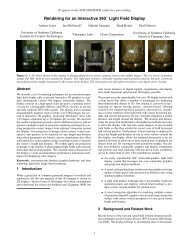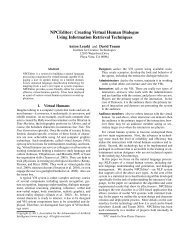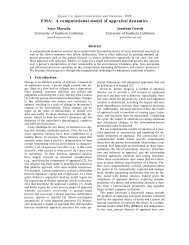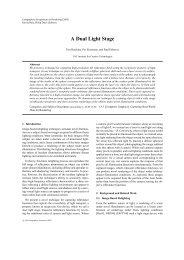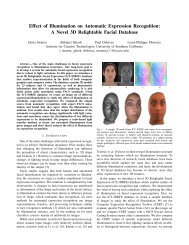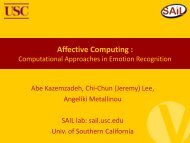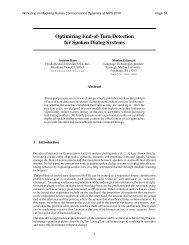Image-based Separation of Diffuse and Specular ... - ICT Graphics Lab
Image-based Separation of Diffuse and Specular ... - ICT Graphics Lab
Image-based Separation of Diffuse and Specular ... - ICT Graphics Lab
Create successful ePaper yourself
Turn your PDF publications into a flip-book with our unique Google optimized e-Paper software.
<strong>Image</strong>-<strong>based</strong> <strong>Separation</strong> <strong>of</strong> <strong>Diffuse</strong> <strong>and</strong> <strong>Specular</strong> Reflections using<br />
Environmental Structured Illumination<br />
Bruce Lamond Pieter Peers Abhijeet Ghosh Paul Debevec<br />
University <strong>of</strong> Southern California, Institute for Creative Technologies<br />
Abstract<br />
We present an image-<strong>based</strong> method for separating diffuse<br />
<strong>and</strong> specular reflections using environmental structured<br />
illumination. Two types <strong>of</strong> structured illumination are<br />
discussed: phase-shifted sine wave patterns, <strong>and</strong> phaseshifted<br />
binary stripe patterns. In both cases the low-pass<br />
filtering nature <strong>of</strong> diffuse reflections is utilized to separate<br />
the reflection components. We illustrate our method on a<br />
wide range <strong>of</strong> example scenes <strong>and</strong> applications.<br />
1. Introduction<br />
An important aspect in underst<strong>and</strong>ing a specific scene is<br />
how it interacts with incident illumination. The two most<br />
widely considered characteristics in reflectance behavior<br />
are diffuse <strong>and</strong> specular reflections. Being able to separate<br />
these two characteristics in a photographed scene, quickly<br />
<strong>and</strong> robustly, is <strong>of</strong> interest for numerous methods in computer<br />
graphics <strong>and</strong> computer vision, e.g., geometrical normal<br />
estimation, <strong>and</strong> reflectance measurement.<br />
In this paper we consider the specific case where incident<br />
illumination originates from (multiple) distant sources.<br />
Often, such incident illumination is modeled in an image<strong>based</strong><br />
fashion by an environment map. Therefore, we call<br />
this kind <strong>of</strong> incident illumination environmental incident illumination.<br />
Unlike single light source conditions, specular<br />
highlights under environmental illumination conditions can<br />
cover large continuous areas <strong>of</strong> the object. Furthermore, different<br />
solid angles <strong>of</strong> incident illumination can significantly<br />
differ in color.<br />
In the presented method, we employ a small set <strong>of</strong> high<br />
frequency structured environmental lighting conditions to<br />
separate diffuse <strong>and</strong> specular reflections from photographs<br />
<strong>of</strong> a scene taken from a single viewpoint. Our method is<br />
completely image-<strong>based</strong>, requires just a few photographs,<br />
<strong>and</strong> only makes mild assumptions about the frequency behavior<br />
<strong>of</strong> the reflectance properties in the scene. The core<br />
idea is that diffuse reflections act as a low-pass filter in the<br />
incident angular domain, <strong>and</strong> can be separated using a b<strong>and</strong>pass<br />
filter. Our method is aimed at separating both components<br />
with an equal degree <strong>of</strong> quality, as opposed to specular<br />
highlight removal methods which focus on the diffuse<br />
component only. This is useful for developing applications<br />
that estimate hybrid photometric normals that rely on either<br />
specular information such as [3, 5, 15, 30] or diffuse<br />
reflectance information [34], <strong>and</strong> for efficiently estimating<br />
reflectance characteristics.<br />
To summarize the contributions <strong>of</strong> this work:<br />
• First, it is to our knowledge the first separation method<br />
to use the local frequency behavior <strong>of</strong> the reflectance<br />
properties, <strong>and</strong> a theoretical justification is provided.<br />
It does not rely on color information or polarization<br />
states.<br />
• Second, it is an image-<strong>based</strong> method where each pixel<br />
in the photograph is processed independently. No segmentation<br />
is required, nor is neighborhood information<br />
used. This allows straightforward component separation<br />
for textured objects.<br />
• Finally, unlike most previous methods that only work<br />
for point light sources or constant area light sources,<br />
our method is able to separate reflection components<br />
under any (controlled) environmental illumination.<br />
2. Previous Work<br />
A large body <strong>of</strong> literature exists on separating reflectance<br />
components. These methods can be subdivided into four<br />
rough categories: polarization <strong>based</strong> methods [4, 15, 18,<br />
33], color <strong>based</strong> methods [1, 9, 11, 13, 14, 16, 17, 27, 28, 29,<br />
35], a combination <strong>of</strong> both [8, 19, 20, 32], or neighborhood<br />
(pixel or temporal) <strong>based</strong> methods [4, 7, 12, 24, 25, 26].<br />
Discussing each technique in detail falls beyond the scope<br />
<strong>of</strong> this paper. Therefore, we will focus this discussion on<br />
the most relevant papers.<br />
Shafer [27] introduced the dichromatic model: a colorless<br />
specular intensity <strong>and</strong> a diffuse chroma. To estimate<br />
the diffuse color, information from multiple pixels is used,<br />
<strong>and</strong> a global diffuse color is estimated. To deal with textured<br />
surfaces, a segmentation is performed, <strong>and</strong> for each<br />
1
segment a diffuse color is computed. However, the need<br />
for segmentation limits the technique’s effectiveness for<br />
highly textured objects. More recent work on color separation<br />
avoids segmentation by making additional assumptions<br />
such as known (or estimated) light source color(s) [16, 17].<br />
Wolff <strong>and</strong> Boult [33] use polarization as an alternative tool<br />
to separate the reflection components. A key observation<br />
is that specular reflections become polarized, while diffuse<br />
reflections are basically unpolarized. Disadvantages are<br />
that multiple photographs are required (with different polarization<br />
directions), <strong>and</strong> that the amount <strong>of</strong> polarization is<br />
dependent on the angles <strong>of</strong> incidence <strong>and</strong> reflection. Nayar<br />
et al. [19] present the first system that combines colorspace<br />
(for the diffuse component) <strong>and</strong> polarization <strong>based</strong><br />
separation (for the specular component). However, their<br />
method only works well for dielectric specular reflections<br />
as opposed to metallic specular reflections.<br />
None <strong>of</strong> the above methods are effective for separating<br />
reflection components under environmental illumination<br />
conditions which may be non uniformly colored. Due<br />
to their reliance on inter-pixel information or knowledge <strong>of</strong><br />
the light source color, color-space methods will not work<br />
well when specular highlights cover large continuous areas<br />
<strong>of</strong> the object. These large highlit areas can cover large non<br />
uniformly colored solid angles <strong>and</strong> are unavoidable when<br />
using environmental illumination. Furthermore, color space<br />
methods generally fail in separating components with the<br />
same color. Polarization methods with unpolarized light<br />
sources require a large number <strong>of</strong> photographs (different<br />
polarization directions), <strong>and</strong> are not always equally effective<br />
for metallic specular reflections.<br />
All <strong>of</strong> the methods above work under uncontrolled or<br />
semi-uncontrolled lighting conditions, making separation<br />
<strong>of</strong> diffuse <strong>and</strong> specular reflections a significantly underconstraint<br />
problem. Methods such as [4, 15, 21] use controlled<br />
illumination to separate diffuse or specular reflections.<br />
However, each <strong>of</strong> these methods rely on a (relative)<br />
sparse angular light source sampling, making them less<br />
suited for scenes containing sharp specular materials.<br />
The method presented here does not rely on polarization<br />
states, or on inter-pixel relations, nor does it impose any restrictions<br />
on the color <strong>of</strong> the materials, light sources, or the<br />
viewpoint. It works equally well for metallic <strong>and</strong> dielectric<br />
specular reflections. It requires as few as three photographs<br />
<strong>of</strong> the scene under controlled illumination.<br />
3. Problem Statement<br />
Before detailing our separation method, we first formalize<br />
the problem <strong>and</strong> introduce necessary notations. Given<br />
diffuse <strong>and</strong> specular reflectance functions for each pixel p<br />
<strong>and</strong> incident lighting directions ω, denoted by D(p, ω) <strong>and</strong><br />
S(p, ω) respectively, the goal is to compute the specular radiance<br />
ρ s (p), <strong>and</strong> diffuse radiance ρ d (p):<br />
ρ d (p) =<br />
ρ s (p) =<br />
∫<br />
∫<br />
Γ<br />
Γ<br />
D(p, ω)Ī(ω) dω, (1)<br />
S(p, ω)Ī(ω) dω, (2)<br />
where Ī(ω) is the lighting environment for which the separation<br />
is desired, <strong>and</strong> Γ is the solid angle over which<br />
Ī(ω) is defined. Unless noted differently we will assume<br />
Γ = Ω (the full sphere <strong>of</strong> incident lighting directions), <strong>and</strong><br />
Ī(ω) = 1.<br />
In this paper we will compute ρ d (p), <strong>and</strong> ρ s (p) from a<br />
few observations E i (p) <strong>of</strong> a scene taken from a fixed vantage<br />
point under different controlled distant environmental<br />
illumination conditions I i . Ignoring inter-reflections, <strong>and</strong><br />
occlusions, the observed radiance E i (p) under the i-th illumination<br />
condition I i is governed by:<br />
∫<br />
E i (p) =<br />
Γ<br />
(D(p, ω) + S(p, ω)) I i (ω) dω, (3)<br />
The presented method will compute ρ d (p) <strong>and</strong> ρ s (p) for<br />
each pixel without using information from other pixels.<br />
Therefore, we drop the reference to a specific pixel p for<br />
notational simplicity.<br />
We will now present two different sets <strong>of</strong> structured illumination<br />
conditions I i , <strong>and</strong> show how they can be used<br />
to extract the diffuse radiance ρ d <strong>and</strong> specular radiance ρ s<br />
from the observations E i .<br />
4. Phase-shifted Sine Wave Patterns<br />
It is well known that diffuse reflectance functions behave<br />
as a low-pass function on the incident illumination (e.g.,<br />
[2, 23]). This allows us to design high frequency environmental<br />
illumination conditions that do not stimulate the diffuse<br />
reflectance function, <strong>and</strong> thus serve to separate diffuse<br />
<strong>and</strong> specular reflection components. A logical example <strong>of</strong><br />
such an illumination condition is a (high frequency) sine<br />
wave pattern over the sphere <strong>of</strong> incident lighting directions.<br />
4.1. Theory<br />
Let us define different sine wave illumination patterns,<br />
each with a fixed frequency f, but with different phases ϕ i :<br />
sin(fφ + ϕ i ), with ω = (θ, φ), <strong>and</strong> dω = sin(θ)dθdφ.<br />
The specific orientation <strong>of</strong> the azimuthal angle φ <strong>and</strong> polar<br />
angle θ does not matter, as long as they are consistently<br />
chosen. Note that these sine wave patterns are constant<br />
over θ. In order to obtain a physically realizable illumination<br />
condition, we add a constant <strong>of</strong>fset, such that the complete<br />
illumination condition has positive values everywhere:<br />
I i (ω) = sin(fφ + ϕ i ) + 1. Inserting this into Equation (3)<br />
gives:
∫<br />
E i = (D(ω) + S(ω)) (sin(fφ + ϕ i ) + 1) dω. (4)<br />
Γ<br />
Since I i is independent <strong>of</strong> θ, we include the integration over<br />
θ into the definition <strong>of</strong> D, <strong>and</strong> S, <strong>and</strong> focus on the integration<br />
over φ. This yields:<br />
∫<br />
E i = ρ d + ρ s + D(φ) sin(fφ + ϕ i )dφ<br />
Γ<br />
∫<br />
+ S(φ) sin(fφ + ϕ i ) dφ. (5)<br />
Γ<br />
If the frequency f is large enough, then the third term is<br />
approximately zero [23]. The fourth term can be written as:<br />
∫<br />
Γ S(φ) sin(fφ + ϕ i) dφ<br />
∫<br />
= S(φ) (sin(fφ) cos(ϕ i ) + cos(fφ) sin(ϕ i )) dφ (6)<br />
Γ<br />
= (cos(ϕ i )S + sin(ϕ i )C) , (7)<br />
where S <strong>and</strong> C are constants only dependent on the specific<br />
form <strong>of</strong> the specular reflectance function S(·). Equation (7)<br />
defines a phase-shifted sine wave, with the phase directly<br />
related to the reflected view-direction <strong>and</strong> the surface<br />
normal. The amplitude <strong>of</strong> this sine wave corresponds to the<br />
magnitude <strong>of</strong> the f-th frequency component <strong>of</strong> S(·). For<br />
sufficiently sharp specular reflections, <strong>and</strong> f low enough,<br />
the f-th frequency component is approximately ρ s , <strong>and</strong><br />
thus the sine wave defined by Equation (7) reaches its<br />
maximum amplitude ρ s for some ϕ peak .<br />
Putting this all together yields:<br />
E peak ≈ ρ d + 2ρ s ,<br />
E peak+π ≈ ρ d .<br />
It is, however, unlikely that one <strong>of</strong> the phases ϕ i equals<br />
exactly ϕ peak , <strong>and</strong> thus E peak is almost never directly observed.<br />
However, ϕ peak can be computed from any collection<br />
<strong>of</strong> three phases ϕ i , as described in the next subsection.<br />
4.2. Implementation<br />
Given three observations E i <strong>of</strong> the scene under phaseshifted<br />
sine waves with phases ϕ i , i ∈ {0, 1, 2}, we can<br />
compute ρ s <strong>and</strong> ρ d as follows. Each observation is <strong>of</strong> the<br />
following form:<br />
(8)<br />
E i = ρ d + ρ s + (cos(ϕ i )S + sin(ϕ i )C) . (9)<br />
We can write this equation as a linear system with three unknowns<br />
A, S <strong>and</strong> C: E i = A+cos(ϕ i )S+sin(ϕ i )C, where<br />
A = ρ d + ρ s . If we have three or more linearly independent<br />
observations (e.g., with phases 0, 60 <strong>and</strong> 120 degrees), then<br />
all three unknowns can be computed by solving the linear<br />
system, or a linear least squares when more than three observations<br />
are made (e.g., for robustness). From this it can<br />
be easily shown that:<br />
ρ d ≈ A − √ S 2 + C 2 ,<br />
ρ s ≈ √ S 2 + C 2 .<br />
(10)<br />
Note that this approach is similar to phase shifting in<br />
structured light-<strong>based</strong> surface reconstruction.<br />
The only question remaining is which frequency f to<br />
use. Ramamoorthi <strong>and</strong> Hanrahan [23] showed that the response<br />
<strong>of</strong> a diffuse reflectance function decays quadratically<br />
with respect to the frequency <strong>of</strong> the incident illumination.<br />
Therefore, to eliminate the effect <strong>of</strong> the diffuse reflections<br />
as much as possible, we recommend using f > 10 as a<br />
lower limit. The upper limit for the frequency f depends on<br />
the roughness <strong>of</strong> the specular reflectance function.<br />
5. Phase-shifted Binary Stripe Patterns<br />
A disadvantage <strong>of</strong> the phase-shifted sine wave patterns<br />
is that they require a radiometrically calibrated emitter capable<br />
<strong>of</strong> emitting a large number <strong>of</strong> intensity values. Often<br />
such a device is not available. Emission <strong>of</strong> binary patterns<br />
is, however, <strong>of</strong>ten easily achievable. An additional<br />
advantage <strong>of</strong> binary patterns is that no radiometric calibration<br />
(<strong>of</strong> the emitter) is required. Therefore, we investigate<br />
whether separation <strong>of</strong> diffuse <strong>and</strong> specular reflections can<br />
still be performed using only binary patterns: more specifically,<br />
phase-shifted binary stripe patterns. These binary<br />
stripe patterns can be viewed as a one-bit quantized version<br />
<strong>of</strong> the phase-shifted sine wave patterns <strong>of</strong> before.<br />
Formally, define a set <strong>of</strong> phase-shifted binary stripe patterns<br />
as:<br />
( ) fφ + ϕi<br />
I i (ω) = Ψ<br />
+ 1, (11)<br />
2π<br />
with ϕ i = 2π<br />
nf<br />
i, n the number <strong>of</strong> illumination patterns, <strong>and</strong>:<br />
{ +1 if x − ⌊x⌋ ∈ [0, 0.5)<br />
Ψ(x) =<br />
(12)<br />
−1 if x − ⌊x⌋ ∈ [0.5, 1).<br />
Inserting these patterns into Equation (3), allows us to write<br />
the observed radiance similarly to Equation (5):<br />
∫<br />
E i = ρ d + ρ s + D(φ)Ψ<br />
Γ<br />
∫ ( ) fφ + ϕi<br />
+ S(φ)Ψ<br />
2π<br />
Γ<br />
( fφ + ϕi<br />
2π<br />
)<br />
dφ<br />
dφ. (13)<br />
We can follow a similar reasoning as with the phaseshifted<br />
sine wave patterns <strong>and</strong> equate the third term to zero.
Peak detection can then be used to obtain the following separation<br />
formula:<br />
ρ d ≈ min i E i ,<br />
ρ s ≈ 1 2 (max i E i − min i E i ) .<br />
Please refer to [10] for an in depth derivation.<br />
6. User-specified Environmental Illumination<br />
(14)<br />
Separating diffuse <strong>and</strong> specular reflections under uniform<br />
illumination is useful, however in many applications<br />
a separation under a particular environmental lighting condition<br />
is required (e.g., gradient illumination [15]). It can<br />
be shown that computing the maximum <strong>and</strong> minimum <strong>of</strong><br />
the observations under phase-shifted binary stripe patterns<br />
modulated by the user-specified environmental illumination<br />
yields the desired separation.<br />
Formally, given some user selected illumination condition<br />
Ī, <strong>and</strong> a set <strong>of</strong> phase-shifted binary stripe patterns<br />
I ′ i, i ∈ {0, ..., n − 1} with frequency f <strong>and</strong><br />
phase ϕ i , the desired separation is a diffuse component:<br />
ρ d = ∫ ∫ Γ D(ω)Ī(ω) dω, <strong>and</strong> a specular component: ρ s =<br />
S(ω)Ī(ω) dω. Now define n novel illumination conditions<br />
I i (ω) = Ī(ω)I′ i(ω). By restricting the selected illu-<br />
Γ<br />
mination condition Ī to not exhibit high frequency changes<br />
in intensity over a distance <strong>of</strong> 2π f<br />
for every point in Ī, a successful<br />
separation can be obtained by computing both components<br />
as in Equations (3) <strong>and</strong> (14). Please refer to [10]<br />
for a more detailed derivation.<br />
7. <strong>Separation</strong> Results<br />
Our experiments use a setup similar to the device presented<br />
in [22], which covers approximately the front half <strong>of</strong><br />
the sphere <strong>of</strong> incident lighting directions. The setup consists<br />
<strong>of</strong> a 1.5m diameter hemisphere coated with a rough<br />
specular surface, a radiometrically calibrated (i.e., gamma<br />
corrected) projector equipped with a fish-eye lens, <strong>and</strong> a radiometrically<br />
calibrated high resolution digital still camera.<br />
The projector is placed close to the focus <strong>of</strong> the hemisphere<br />
<strong>and</strong> aimed at the apex. The target object is placed near the<br />
lens <strong>of</strong> the projector. Finally, a camera is placed outside the<br />
dome <strong>and</strong> views the target object through a hole at the apex<br />
<strong>of</strong> the dome. Illumination patterns are emitted from the projector<br />
onto the dome, where they are subsequently reflected<br />
back towards the target object. The rough specular coating<br />
minimizes inter-reflections within the dome, while reflecting<br />
a maximum amount <strong>of</strong> light towards the target object.<br />
Note that our method is not limited to this acquisition device,<br />
<strong>and</strong> any extended controllable light source such as a<br />
CRT or TFT screen can be used.<br />
A practical concern when projecting the phase-shifted<br />
sine-wave patterns, is to avoid the singularities at the poles.<br />
The first reason is that inaccuracies due to the limited resolution<br />
<strong>of</strong> the emitter can significantly impact accuracy in<br />
such a case. A second more fundamental issue is that while<br />
high frequencies are guaranteed to have a negligible impact<br />
on the diffuse reflections, there is no guarantee that it will<br />
have a non-zero impact on specular reflections. This is especially<br />
the case when the specular lobe is centered around<br />
the singularity. In order to avoid these problems, we directly<br />
emit a phase-shifted sine-wave pattern in the native<br />
parameterization <strong>of</strong> the emitter. While this does not exactly<br />
correspond to the theoretical patterns, we found that it still<br />
works well in practice, <strong>and</strong> avoids the singularity issues.<br />
Figure 1 shows separations on four different objects. The<br />
leftmost example is obtained using phase-shifted sine wave<br />
patterns as in Section 4. The two middle examples are obtained<br />
using the phase-shifted binary stripe patterns as in<br />
Section 5. The rightmost example shows a separation result<br />
under user selected environmental illumination as in Section<br />
6. The brightness <strong>of</strong> the individual components have<br />
been adapted for optimal viewing.<br />
8. Discussion<br />
The two presented methods have their advantages <strong>and</strong><br />
disadvantages.<br />
The phase-shifted sine wave patterns allow the peak<br />
phase to be computed from more than the minimum three<br />
measurements by solving a linear least squares system. This<br />
provides a convenient way to counteract potential measurement<br />
noise <strong>of</strong> the camera <strong>and</strong> brightness fluctuations due<br />
to the emitter. Because the computation <strong>of</strong> the components<br />
from the phase-shifted binary stripe patterns relies on the<br />
minimum <strong>and</strong> maximum observed intensities, the effect <strong>of</strong><br />
measurement noise cannot be easily resolved by emitting<br />
more stripe patterns.<br />
The binary stripe patterns, however, have the advantage<br />
that they do not require radiometric calibration <strong>of</strong> the emitter.<br />
Additionally, the computational simplicity <strong>and</strong> ease <strong>of</strong><br />
implementation make this method very attractive. The cost<br />
<strong>of</strong> this simplicity is that this method is less forgiving to selecting<br />
an insufficient frequency range, although using more<br />
illumination patterns with different phases can partially resolve<br />
this. The phase-shifted sine wave patterns fail more<br />
gracefully due to their smoother appearance <strong>and</strong> analytical<br />
computation <strong>of</strong> the peak phase. This behavior is especially<br />
useful when separating objects that contain a wide range <strong>of</strong><br />
specular reflectance functions (e.g., both dull <strong>and</strong> sharp reflectance<br />
functions in a single scene). Please refer to [10]<br />
for an in depth discussion <strong>and</strong> illustrations <strong>of</strong> the effects <strong>of</strong><br />
using different frequency patterns.<br />
Limitations: In our previous discussion we have ignored<br />
inter-reflections, <strong>and</strong> the effects <strong>of</strong> occlusions.
<strong>Diffuse</strong> + <strong>Specular</strong> Components <strong>Diffuse</strong> Component <strong>Specular</strong> Component<br />
Figure 1. Results <strong>of</strong> our separation method. Left: separation using phase-shifted sine wave patterns. Middle (2): separation using phaseshifted<br />
stripe patterns. Right: separation under user-specified environmental illumination (shown in the inset).<br />
Occlusions are light transport effects that change the frequency<br />
content <strong>of</strong> the reflectance functions. Hence, artifacts<br />
are introduced when separating. Increasing the frequency <strong>of</strong><br />
the patterns helps to avoid these artifacts, but at the cost <strong>of</strong><br />
potentially classifying parts <strong>of</strong> rough specular reflections as<br />
diffuse. Related to occlusions is the use <strong>of</strong> extended light<br />
sources that do not cover the whole sphere <strong>of</strong> incident lighting<br />
directions. Conceptually, lighting directions not covered<br />
by the light source can be considered occluded, <strong>and</strong> as such,<br />
similar artifacts occur.<br />
Inter-reflections also influence the separation. Many previous<br />
methods only h<strong>and</strong>le inter-reflections partially, or not<br />
at all. The presented method deals correctly with multiple<br />
specular reflections. Any diffuse inter-reflection, however,<br />
will result in an incorrect separation due to the low-pass behavior<br />
<strong>of</strong> diffuse reflections which removes any frequency<br />
information from the incident illumination.<br />
Validation: We have compared the presented method to a<br />
polarization <strong>based</strong> separation approach. We covered a CRT<br />
monitor with a linear polarization sheet. A series <strong>of</strong> photographs<br />
with a linear polarizer rotated to a range <strong>of</strong> different<br />
orientations in steps <strong>of</strong> 6 degrees placed in front <strong>of</strong><br />
the camera are captured <strong>of</strong> the object under constant illumination.<br />
Computing the minimum <strong>and</strong> maximum per pixel<br />
yields the cross polarized <strong>and</strong> parallel polarized photograph<br />
<strong>of</strong> the scene. Additionally, we also compute separations under<br />
phase-shifted stripe <strong>and</strong> sine wave patterns. We calibrated<br />
the patterns such that each period covers approximately<br />
the same solid angle when viewed from the object.<br />
All three separations are comparable in quality. Differences<br />
were mainly due to non-specular polarization maintaining<br />
reflections, occlusions, <strong>and</strong> the limited coverage <strong>of</strong><br />
the sphere <strong>of</strong> incident lighting directions by the CRT monitor.<br />
Please refer to [10] for a visual comparison.
Relation to Nayar et al. [21]: The presented method, especially<br />
the phase-shifted stripe patterns, bears similarities<br />
to [21] which presents a method to separate direct <strong>and</strong> indirect<br />
reflections from a point light source (e.g., a projector).<br />
However, this work differs fundamentally from our diffusespecular<br />
separation method.<br />
A important theoretical key difference is that we separate<br />
local reflection components (an interaction at a single<br />
surface point), while Nayar et al. separates global reflection<br />
effects (interactions between different surface points).<br />
Another practical difference is that Nayar et al. project illumination<br />
directly onto the scene from (approximately) a<br />
point light source. In our setup we use an area light source<br />
(indirectly via a hemispherical dome or the surface <strong>of</strong> a<br />
CRT monitor). Further, Nayar et al. consider the spatial<br />
frequency behavior <strong>of</strong> the incident illumination (from a single<br />
direction per camera pixel) on the scene, whereas our<br />
methods look at the angular frequency behavior <strong>of</strong> a single<br />
spatial location (i.e., pixel). Thus the two methods operate<br />
on different domains.<br />
An interesting case is where the effects <strong>of</strong> local <strong>and</strong><br />
global interactions overlap. Such a case occurs when the<br />
diffuse component is solely due to subsurface scattering.<br />
<strong>Specular</strong> reflections, on the other h<strong>and</strong>, are always first<br />
surface reflection effects, <strong>and</strong> thus correspond to directly<br />
reflected illumination. Consequently, for this case only,<br />
Nayar et al. are able to separate diffuse <strong>and</strong> specular reflections<br />
from a point light source. Correspondingly, our<br />
method is able to separate direct <strong>and</strong> indirect reflections<br />
from extended light sources. Generally, however, the separated<br />
components from these two techniques will not correspond<br />
to the same physical phenomena.<br />
It should be noted that the projector resolution limits the<br />
effective resolution <strong>of</strong> the camera in Nayar et al., <strong>and</strong> thus<br />
consequently the amount <strong>of</strong> detail that can be captured. The<br />
presented method on the other h<strong>and</strong> requires photographs<br />
<strong>of</strong> sufficiently high resolution such that the solid angle <strong>of</strong> a<br />
specular reflection through a pixel covers less then a single<br />
period <strong>of</strong> the phase-shifted patterns.<br />
9. Applications<br />
We envision a large number <strong>of</strong> applications that can benefit<br />
from using our separation method, which is especially<br />
suited for methods that require structured illumination to<br />
start with. Due to space restrictions, we will only discuss<br />
two applications: photometric normal estimation, <strong>and</strong><br />
spatially-varying BRDF (SVBRDF) estimation. Our goal<br />
is to illustrate that our method is applicable in many situations.<br />
Comparing the quality to comparable alternative<br />
methods falls outside the scope <strong>of</strong> this paper.<br />
Photometric Normal Estimation: A number <strong>of</strong> methods<br />
have been developed for estimating normals from diffuse<br />
<strong>and</strong> specular reflections. In our application, we use an evolution<br />
<strong>of</strong> example-<strong>based</strong> photometric stereo [6]. We compute<br />
the separated diffuse <strong>and</strong> specular components under<br />
three illumination conditions. Inspired by [15] we use linear<br />
gradient patterns. However, in order to avoid exact geometric<br />
calibration <strong>of</strong> the emitted pattern (which depends<br />
on the shape <strong>of</strong> the emitter <strong>and</strong> the relative location <strong>of</strong> the<br />
object), we also capture a diffuse <strong>and</strong> specular sphere under<br />
the same illumination conditions. For both components, we<br />
correspond for each pixel on the object its normalized intensity<br />
to the normalized intensity on the corresponding diffuse<br />
<strong>and</strong> specular sphere. The normalization ensures that we remove<br />
the effects <strong>of</strong> the albedo. The pixel location on the<br />
sphere <strong>of</strong> the matching normalized intensity, can then be<br />
directly translated into a normal direction.<br />
Figure 2 shows false color images <strong>of</strong> the normals <strong>of</strong> the<br />
Sake set <strong>of</strong> Figure 1 computed from the separated diffuse<br />
<strong>and</strong> specular reflections. The inset shows the false color<br />
coding <strong>of</strong> normal directions on a sphere. Note that a low<br />
albedo aversely affects the diffuse normal estimation, while<br />
the specular normals do not suffer from this. Occlusions<br />
also impact the estimation <strong>of</strong> the normals differently for<br />
both components. In the diffuse case, normals are bent towards<br />
the occluder. Normals estimated from the specular<br />
component are affected less due to their more narrow angular<br />
support. However, the range <strong>of</strong> surface normals that can<br />
be estimated from specular reflections is currently limited<br />
by the angular extent <strong>of</strong> the hemispherical setup used.<br />
SVBRDF Estimation: We can use our separation method<br />
to capture <strong>and</strong> fit SVBRDFs. For simplicity we assume that<br />
the SVBRDF is isotropic, <strong>and</strong> that the diffuse reflection is<br />
Lambertian. We use the separation under uniform illumination<br />
to compute the specular <strong>and</strong> diffuse albedo, <strong>and</strong> use<br />
the above photometric normal estimation technique to obtain<br />
surface normals. We fit a diffuse BRDF using the diffuse<br />
albedo for each pixel. Next, we sample the SVBRDF<br />
from 10 lighting directions <strong>and</strong> subtract for each pixel the<br />
effect <strong>of</strong> the diffuse BRDF. We further segment the sample<br />
manually into regions with different specular BRDFs. For<br />
each region a Torrance-Sparrow [31] lobe is fitted to the remaining<br />
specular reflections from the 10 sampled lighting<br />
directions. Figure 3 shows a visualization <strong>and</strong> a reference<br />
photograph <strong>of</strong> an SVBRDF. There are differences notable<br />
due to the fact that we use a directional light source for visualizing<br />
the SVBRDF, which underestimates the extent <strong>of</strong><br />
the reference light source.<br />
10. Conclusion<br />
We have presented an image-<strong>based</strong> method that exploits<br />
specific frequency behaviors <strong>of</strong> reflectance functions for<br />
separating reflection components under environmental illumination.<br />
Our method does not rely on polarization, color-
Figure 2. Normals computed from example-<strong>based</strong> photometric<br />
stereo <strong>based</strong> on the separate diffuse (left) <strong>and</strong> specular (right) components.<br />
Figure 3. SVBRDF estimated with separated diffuse <strong>and</strong> specular<br />
albedos. Left: a reference photograph under a point light source.<br />
Right: a visualization <strong>of</strong> fitted SVBRDF parameters under similar<br />
lighting conditions.<br />
space, or spatial/temporal neighborhood information. Two<br />
different sets <strong>of</strong> structured environmental illumination patterns<br />
were presented to achieve this separation. Finally, an<br />
extension was introduced to separate reflection components<br />
<strong>of</strong> a scene lit by a user-selected environmental illumination.<br />
For future work we would like to improve the photometric<br />
stereo application presented in this paper. We also would<br />
like to investigate how to extend this method to uncontrolled<br />
incident light fields.<br />
References<br />
[1] R. Bajscy, S. Lee, <strong>and</strong> A. Leonardis. Detection <strong>of</strong> diffuse <strong>and</strong><br />
specular interface reflections by color image segmentation.<br />
IJCV, 17(3), 1996. 1<br />
[2] R. Basri <strong>and</strong> D. W. Jacobs. Lambertian reflectance <strong>and</strong> linear<br />
subspaces. PAMI, 25(2), 2003. 2<br />
[3] T. Chen, M. Goesele, <strong>and</strong> H. P. Seidel. Mesostructure from<br />
specularities. In CVPR, pages 1825–1832, 2006. 1<br />
[4] P. Debevec, T. Hawkins, C. Tchou, H.-P. Duiker, W. Sarokin,<br />
<strong>and</strong> M. Sagar. Acquiring the reflectance field <strong>of</strong> a human<br />
face. In ACM SIGGRAPH, 2000. 1, 2<br />
[5] Y. Francken, T. Cuypers, T. Mertens, J. Gielis, <strong>and</strong><br />
P. Bekaert. High quality mesostructure acquisition using<br />
specularities. In CVPR, 2008. 1<br />
[6] A. Hertzmann <strong>and</strong> S. M. Seitz. Example-<strong>based</strong> photometric<br />
stereo: Shape reconstruction with general, varying brdfs.<br />
PAMI, 27(8):1254–1264, 2005. 6<br />
[7] A. Jaklic <strong>and</strong> F. Solina. Separating diffuse <strong>and</strong> specular component<br />
<strong>of</strong> image irradiance by translating a camera. In CAIP,<br />
1993. 1<br />
[8] D. Kim <strong>and</strong> S. Lin. Variational specular separation using<br />
color <strong>and</strong> polarization. In IAPR, 2002. 1<br />
[9] G. J. Klinker, S. A. Shafer, <strong>and</strong> T. Kanade. The measurement<br />
<strong>of</strong> highlights in color images. IJCV, 2, 1988. 1<br />
[10] B. Lamond, P. Peers, A. Ghosh, <strong>and</strong> P. Debevec. <strong>Image</strong><strong>based</strong><br />
separation <strong>of</strong> diffuse <strong>and</strong> specular reflections using environmental<br />
structured illumination, supplemental material.<br />
Technical report, USC, 2009. <strong>ICT</strong>-TR-01-2009. 4, 5<br />
[11] S. Lee, H. Koo, N. Cho, <strong>and</strong> J. Park. Stochastic approach to<br />
separate diffuse <strong>and</strong> specular reflections. In ICIP, 2006. 1<br />
[12] S. Lin <strong>and</strong> S. W. Lee. Estimation <strong>of</strong> diffuse <strong>and</strong> specular<br />
appearance. In ICCV, 1999. 1<br />
[13] S. Lin, Y. Li, S. B. Kang, X. Tong, <strong>and</strong> H.-Y. Shum.<br />
<strong>Diffuse</strong>-specular separation <strong>and</strong> depth recovery from image<br />
sequences. In ECCV, 2002. 1<br />
[14] S. Lin <strong>and</strong> H.-Y. Shum. <strong>Separation</strong> <strong>of</strong> diffuse <strong>and</strong> specular<br />
reflection in color images. CVPR, 2001. 1<br />
[15] W.-C. Ma, T. Hawkins, P. Peers, C.-F. Chabert, M. Weiss,<br />
<strong>and</strong> P. Debevec. Rapid acquisition <strong>of</strong> specular <strong>and</strong> diffuse<br />
normal maps from polarized spherical gradient illumination.<br />
In EGSR, June 2007. 1, 2, 4, 6<br />
[16] S. P. Mallick, T. Zickler, P. N. Belhumeur, <strong>and</strong> D. J. Kriegman.<br />
<strong>Specular</strong>ity removal in images <strong>and</strong> videos: A pde approach.<br />
In ECCV, 2006. 1, 2<br />
[17] S. P. Mallick, T. E. Zickler, D. J. Kriegman, <strong>and</strong> P. N. Belhumeur.<br />
Beyond lambert: Reconstructing specular surfaces<br />
using color. CVPR, pages 619–626, 2005. 1, 2<br />
[18] V. Müller. Elimination <strong>of</strong> specular surface-reflectance using<br />
polarized <strong>and</strong> unpolarized light. In ECCV, 1996. 1<br />
[19] S. Nayar, X. Fang, <strong>and</strong> T. Boult. Removal <strong>of</strong> <strong>Specular</strong>ities<br />
using Color <strong>and</strong> Polarization. In CVPR, 1993. 1, 2<br />
[20] S. K. Nayar, X.-S. Fang, <strong>and</strong> T. Boult. <strong>Separation</strong> <strong>of</strong> reflection<br />
components using color <strong>and</strong> polarization. IJCV, 21(3),<br />
1997. 1<br />
[21] S. K. Nayar, G. Krishnan, M. D. Grossberg, <strong>and</strong> R. Raskar.<br />
Fast separation <strong>of</strong> direct <strong>and</strong> global components <strong>of</strong> a scene<br />
using high frequency illumination. ACM TOG, 25(3), 2006.<br />
2, 6<br />
[22] P. Peers, T. Hawkins, <strong>and</strong> P. Debevec. A reflective light stage.<br />
Technical report, USC, 2006. <strong>ICT</strong>-TR-04-2006. 4<br />
[23] R. Ramamoorthi <strong>and</strong> P. Hanrahan. The relationship between<br />
radiance <strong>and</strong> irradiance: Determining the illumination from<br />
images <strong>of</strong> a convex lambertian object. In Journal Opt. Soc.<br />
Am., 2001. 2, 3<br />
[24] R.Tan <strong>and</strong> K. Ikeuchi. Separating reflection components <strong>of</strong><br />
textured surfaces using a single image. PAMI, 27(2), 2005. 1<br />
[25] Y. Sato <strong>and</strong> K. Ikeuchi. Temporal-color space analysis <strong>of</strong><br />
reflection. Journal Opt. Soc. Am., 11, 1994. 1<br />
[26] Y. Sato, M. D. Wheeler, <strong>and</strong> K. Ikeuchi. Object shape <strong>and</strong><br />
reflectance modeling from observation. Computer <strong>Graphics</strong>,<br />
31, 1997. 1
[27] S. Shafer. Using color to separate reflection components.<br />
COLOR Research <strong>and</strong> Applications, 10(4), 1985. 1<br />
[28] R. Tan <strong>and</strong> K. Ikeuchi. Reflection components decomposition<br />
<strong>of</strong> textured surfaces using linear basis functions. In<br />
CVPR, 2005. 1<br />
[29] R. T. Tan, K. Nishino, <strong>and</strong> K. Ikeuchi. Separating reflection<br />
components <strong>based</strong> on chromaticity <strong>and</strong> noise analysis. PAMI,<br />
26(10), 2004. 1<br />
[30] M. Tarini, H. P. A. Lensch, M. Goesele, <strong>and</strong> H.-P. Seidel. 3d<br />
acquisition <strong>of</strong> mirroring objects. Graphical Models, 67(4),<br />
2005. 1<br />
[31] K. E. Torrance <strong>and</strong> E. M. Sparrow. Theory <strong>of</strong> <strong>of</strong>f-specular reflection<br />
from roughened surfaces. J. Opt. Soc. Am., 57:1104–<br />
1114, 1967. 6<br />
[32] S. Umeyama <strong>and</strong> G. Godin. <strong>Separation</strong> <strong>of</strong> diffuse <strong>and</strong> specular<br />
components <strong>of</strong> surface reflection by use <strong>of</strong> polarization<br />
<strong>and</strong> statistical analysis <strong>of</strong> images. PAMI, 26(5), 2004. 1<br />
[33] L. Wolff <strong>and</strong> T. Boult. Constraining object features using<br />
polarization reflectance model. PAMI, 13(7), 1991. 1, 2<br />
[34] R. J. Woodham, Y. Iwahori, <strong>and</strong> R. A. Barman. Photometric<br />
stereo: Lambertian reflectance <strong>and</strong> light sources with unknown<br />
direction <strong>and</strong> strength. Technical Report TR-91-18,<br />
1991. 1<br />
[35] K. Yoon, Y. Choi, <strong>and</strong> I. Kweon. Fast separation <strong>of</strong> reflection<br />
components using a specularity-invariant image representation.<br />
In ICIP, 2006. 1



